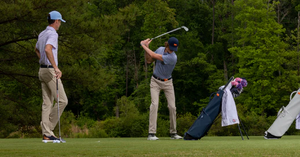What Wedges Should a Beginner Carry?
Putters and wedges are arguably the most important clubs in your golf bag. Wedges come in various types that serve multiple purposes, but they all accomplish the same broad goal: to pop the ball into the air and propel it to the hole - provided it's less than 100 yards out.
A beginner only needs to carry two types of wedges to cover the whole gamut of this type of club's unique function. In the following guide, we'll dive into types, reasoning, and how you can begin to master them.
Wedges a Beginner Golfer Should Carry in Their Bag
Golf is one of the oldest sports still played today - and its influence continues to expand around the globe. Naturally, over time, the equipment, rules, and gameplay got more sophisticated. Especially as it relates to clubs, it's easy to get lost in all the options for putters, wedges, drivers, and irons.
But with wedges, it's essential to keep it economical. Why? With only fourteen slots in your golf bag, beginners can just bring their pitching and sanding wedge along. Let's go over these wedges quickly.
Pitching Wedge
Pitching wedges are among the most versatile clubs you can buy, making them an essential pick if you're trying to weed out the good from the bad. Pitching, gap, sand, and lob wedges are all differentiated based on their loft angle, which refers to how high the club will pop the ball into the sky - and the angle or speed it'll spin.
The pitching variety generally has a 46-48 degree loft angle, which makes it perfect for pitch shots, or shots that soar high but land softly.
Sand Wedge
Where pitching wedges have the lowest loft angle in the bunch, sand wedges are nestled right between the high-angle lob wedge and the mid-angle gap wedge. What's with the name? Sand wedges are most frequently used for saving golf balls from an untimely demise in sand bunkers. (We've all been there!)
The relatively weak loft angle (54 - 56 degrees) makes for a high shot and rapid spin. You need a lot of bounce to retrieve a ball from a sand trap, and this type of wedge will help a player shoot up and out with precision and control.
Why Should You Start With a Pitching and Sand Wedge?
Out of pitching, sand, lob, and gap wedges, these first two are essential, whereas lob and gap wedges are less imperative for beginners. Here's why:
Improved Control
A 9-iron will give you the power to drive the ball forward onto the green, but wedges are essential for tight shots that may require more control. Pitching wedges are harder to control for beginners, but because sand wedges are so short, the club head is so heavy, and because of the loft angle, you have much more control.
A sand wedge will help cut down on slice and hook, so you drive the ball straight toward the hole.
Increased Distance
It's true that wedges are designed for highly technical short-distance shots. But how much distance you're able to cover does matter. The lower the degree of loft angle, the further you'll be able to get the ball.
Pitching and gap wedges, which range between 46 and 52 degrees, get the ball further, whereas lob and gap wedges are better for tight, high-flying shots. The pitching wedge, in particular, has fantastic versatility, spanning the gap between approach shots and medium to long-distance shots.
Sufficient Spin
Not only will you hit the ball further and with more control with these types of clubs, but you'll also get an incredible amount of spin out of them. Spin not only helps the ball travel further, but it can also be used strategically in relation to hole placement.
If you're dredging a ball out of a sand trap and expect to overshoot the hole, you can put a backspin on the ball with the hopes it rolls back into the hole after landing.
When Should You Use a Pitching Wedge?
Also called the “scoring club,” the pitching wedge is a versatile club that is the key to lowering your score. You'll find yourself reaching for the pitching wedge more than most of the clubs in your golf bag as you learn to master it.
To use the pitching wedge properly, focus on hitting down on the ball. It will give you spin and project the ball further, but it also helps with control. You'll lose some control if you use your pitching wedge for medium to long-distance shots - but the low loft angle on this club means you can drive it straight on.
You can also use this club for chip shots - or low shots played along the ground close to the green. These shots are closer to putts, as they don't spend much time in the air, unlike pitch shots!
When Should You Use a Sand Wedge?
Every player needs to know how to rescue their ball from sand bunkers. It's an inevitable part of the game, and even if you're close to perfect, your ball will sooner or later end up in the sand. This is where the sand wedge comes in.
Mastering your sand wedge will help lower your scores, and you'll have more fun. To properly use the sand wedge, you must train your eye on a spot two inches from where the ball lies. Drive the club down at that spot, and you'll connect perfectly with the ball through the sand. It's just as important to follow through on your swing so the ball gets a proper amount of spin to propel it out of that pesky sand bunker.
Additional Wedges You Might Choose To Carry
We've covered pitching and sand wedges, but what about the wedges we left out? Gap and lob wedges serve their own distinct purposes, and as you progress skill, you may naturally seek them out. Why? They absolutely fill in the gaps between pitching and sand wedges.
Gap Wedge
Gap wedges are closest to pitching in loft angle, meaning they're best utilized for longer distance shots. You may find that these wedges don't get quite as much spin as sand or lob wedges - and you certainly won't have as much control. Perhaps not the best for beginners!
The range in loft angle spans from 50 to 54 degrees. A gap wedge is recommended if you're anywhere from 90 to 110 yards out. As a beginner, you may not even be able to eyeball that distance (which is why rangefinders are so important). But over time, you'll be able to sense the best clubs for your distance shots intuitively.
Lob Wedge
Lob wedges have the highest degree loft angle in the golf bag. They're ideal for play shots around the green. Not to be confused with a putter, which has an even more precise and delicate purpose, a lob wedge is used for green play when you still need to loft the ball into the air. This is something a putter cannot do!
Lobs may also be used for chipping and tight lies, where maximum spin is required. If you have a high handicap, you may not want to concern yourself with spin or control. But if you can handle it, you can achieve a staggering level of control with your lob wedge.
Frequently Asked Questions
Does a Beginner Need a 60 Degree Wedge?
In short, no. 60 degrees is relatively high for a wedge as a beginner. If you're a long-time golfer with a low handicap, feel free to carry around a lob wedge with a 60-degree loft angle. But if you're closer to the beginner's side, smart small - don't concern yourself with a high-angle wedge. Opt for pitching and sand wedges as you build your skills and instill a love for the game.
Shop Stitch Golf!
Golf is a sophisticated, highly technical sport. Half the fun is learning how to play the game! That means researching each type of club, watching others play with them, and learning the skills you need to master them.
Stitch Golf has everything you need to improve your game, on and off the green. From apparel like pullovers and polos to travel bags and accessories of all shapes and sizes, we have everything you need to get your mind in the game.



